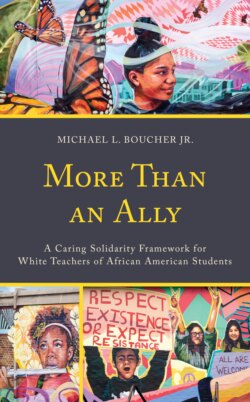Читать книгу More Than an Ally - Michael L. Boucher Jr. - Страница 4
На сайте Литреса книга снята с продажи.
Introduction
ОглавлениеGreat Teachers Need a Framework to Talk about Race
Race has moved from a taboo topic to the center of political and social discourse as people of color have continued the long tradition of advocating for themselves and their children. There was a move into public consciousness that was accelerated after the acquittal of George Zimmerman for the killing of Trayvon Martin in 2013 (Love, 2014), with the use of social media and the Twitter hashtag #BlackLivesMatter by Alicia Garza, Patrisse Cullors, and Opal Tometi. This new generation of activists was stirred after the killing of Michael Brown in Ferguson, Missouri. Corresponding events and movements such as the Movement for Black Lives have pushed White Americans who want to work toward a more equitable society to examine history, structures, and the essential nature of the country.
This examination means that people are talking about race on a regular basis, yet the conversations are not yet producing the kind of increased awareness and empathy that lead to substantial change. Why is that? When race is discussed, the solution is seldom dismantling the structures that keep powerful people in power and others on the margins. In schools, talking about race, when it’s done at all, is done to people and not with them—making solutions elusive not because they are truly impossible but because their cost in money, place, and privilege is perceived as too high. Thus, the talk continues without results, often devolving into blaming the victims of racism.
After a successful career of teaching in urban schools, I began this research in 2009 when it seemed like Americans were ready to talk with clarity about race. The United States had just elected its first Black president, who campaigned on hope and unity. More people of color were coming into leadership positions in both the public and private sectors. From social media to popular culture, it seemed that Americans were on the verge of finally having an honest dialogue about race. What many of us did not fully understand, however, was that there was a storm of resentment brewing against that progress.
The election of 2016 blew in and exploded the fragile structure of White racial understanding (see “Capitalizing White” in the introduction). Instead of moving forward, many White people have become confused about the difference between lie and fact, concerned with their own position, and defensive of their personal status (DiAngelo, 2011; Coates, 2017). The last decade has been dizzying and has left many well-intentioned White people convinced that something must change but without a clear framework as to what that change should look like.
White teachers who seek relationships with students based on solidarity see #BlackLivesMatter and want to create classrooms that reflect that their students matter and that their experiences matter. However, other teachers have sometimes participated in the varied backlashes to the movement, such as denying that race exists, deliberately misunderstanding (#AllLivesMatter), and silencing student protests.
The election of Donald Trump was a gut punch to White people who assumed that the country was moving ahead in race relations (Sondel, Baggett, & Dunn, 2018). The current news climate has only increased the tempo and frequency of race conversations, but again they are frequently unproductive. As race, racism, and White supremacy are being debated hour by hour, the absurdity of our current discourse can be overwhelming to White teachers looking to create a more just and inclusive America. These teachers are trying to understand how they can become more than just casual observers of racism and more than nonracists. They are seeking to move to a deeper level of solidarity with people of color (Applebaum, 2011; Gaztambide-Fernández, 2012).
Given the tenor of the conversation around race, picking up this book and considering its contents is either an act of defiance or one of devotion. Whether it is defiance in the face of increasing polarization across the political and social landscape in all its forms, or if the motivation comes from a devotion to the art, craft, and calling of being an impactful educator, this book should be helpful in either endeavor. It is an attempt to empower White teachers and teacher candidates[1] to do the hard work of interrogating their own racial privilege and joining in caring solidarity with their students.
My research over the last decade has shown that White teachers seeking success in their work that serves predominantly African American students should look within and interrogate their own whiteness. They should look for ways to dismantle structures of racial oppression and privilege in their schools and communities. However, the road to that self-awareness is fraught with pitfalls.
